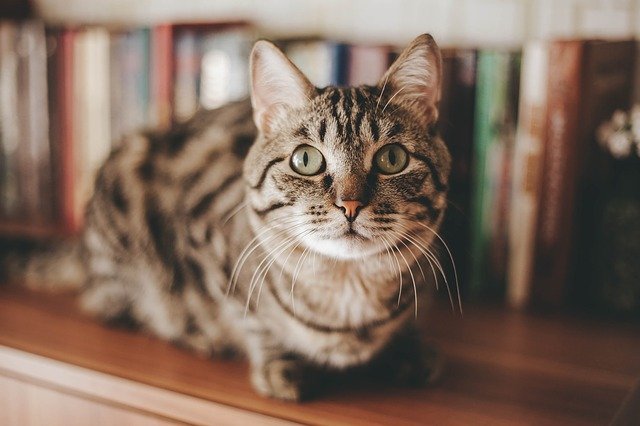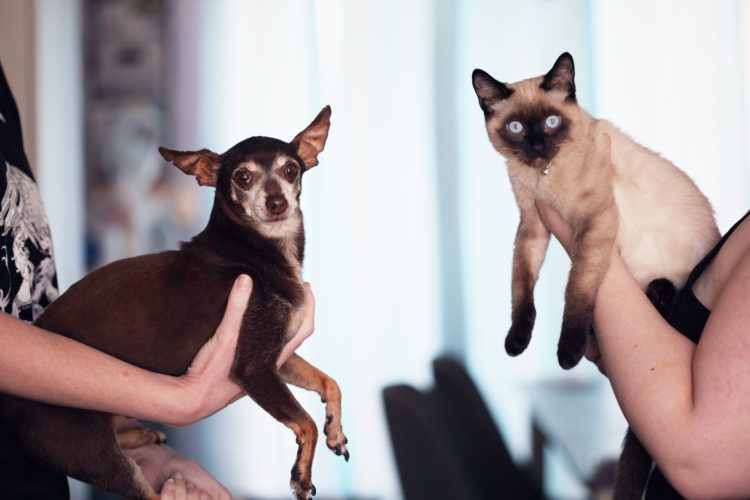How to Introduce Cats and Kittens to Other Animals
Here’s a guide to ensure that introducing your cat or kitten to other animals goes as smoothly and as friendly as possible…
First impressions count when introducing your cat or kitten
What an exciting day it is when you bring your new kitten or cat home. Everyone wants to meet them and you know that all your friends and family, including the furry and feathered variety, will love this fluffy bundle of feline fun! Or will they?
Unfortunately the statement “first impressions count” is as true for our pets as it is for people. Start off on the wrong foot (or paw!) and the relationship between your new cat and the other members of your household may never blossom into friendship.
While it is very tempting to introduce your new cat to everyone and everything all at once, imagine how overwhelming it is for a young animal. Not only have you left the security of your mum, siblings and familiar surroundings but you are suddenly tossed into a world of new scents, sounds and other creatures who are wishing you hadn’t arrived at all!
Instead, how much easier it would be if you had time to get to know your new human owners, your bed, food bowl and the daily routine of the house. Then you’d feel settled and ready to get to know your new animal family. A little forethought can ensure that your cat has the best beginning in your household.

Settling In Your New Cat
When you get you cat home, take them to a room where they are secure. Remember it is easy for cats to escape so make sure your windows and door are closed.
Have their bed and a water bowl set up. Also a litter tray but keep this as far away from the other items as possible. Cats don’t want to sleep next to their toilet.
Get to know your new cat in this area. feed them little and often, as they will associate this pleasant experience with you. Bring other human family members in, but not too many at once.
Over the next few days, you might like to move your cat for an hour or so into a different area. Remove any other animals from the vicinity but let your new cat sniff around their belongings and spaces. You could let your other pets into the new cat’s room while they are absent, to let them sniff around.
Swap items with scent from your exisiting pets to your cat and vice versa. Animals place more importance on scent than humans do, so making the new scent a pleasant experience to encounter will aid in face-to-face introductions.
Gradually does it when introducing your new cat
Gradual, gradual, gradual. If there is one phrase that behaviourists say more than any others, it would have to be this one.
Give your new cat time to settle in to their new environment before you begin introductions to your other pets. This may be a few hours or even days and when they finally do come face-to-face, a few minutes may be sufficient at first. Control of the situation is extremely important to avoid any negative experiences, so keep at least one of the animals restrained initially until they are used to one another.
You can have your new cat in their cat carrier and place it up high to give the cat a feeling of security when in the room with another pet. Control he movements of the other pet so that they don’t scare your cat. For instance, keep a dog on a lead. If you have more than one other pet, introduce them one at a time.
Gradually build up the time the animals have together and their freedom within the shared space. Your patience at this stage will help all future interactions between your pets. Go at your pets’ pace.
Motivate your pets when introducing your new cat
Cats by nature are curious creatures and want to explore. They also want to get to know you and to find food and toys. Use all this knowledge to your advantage during introductions.
Consider what may motivate your existing pets. Cats may enjoy a special treat or simply a stroke along their back. Dogs may like a doggy treat when they sit quietly. Reward the good behaviour of your existing pets during introductions to the new feline arrival.
Encourage any friends and family members you have to help out too. Having one person present for each animal is always a good idea with introductions but ensure they are capable of handling your animals.
Introducing your cat to other animals… Introductions Pet by Pet
Cat to cat
Individual temperament and experience determine how your older cat will view your new feline friend. A well-socialised cat will likely have little trouble in accepting a new arrival, if introduced in a calm and controlled manner, but a cat who has little experience with other cats may hiss, spit and let their feeling be known!
Keep your new cat in their carry case and let the existing cat sniff around. Allow them to spend time in the same room. Then you may like to reverse the situation, if being in the case does not stress your existing cat. Then the two cats can be out in the same room together, giving them space to get away form one another.
Allow the two cats to be together for a short spell, if they wish, but monitor the situation carefully. If either cat gets irritated by the other’s presence, then separate them. Do not be too horrified your older cat tells off the younger one off for too-boisterous play. This is natural.
Do not leave the cats alone together until you are confident that neither cat will get hurt and always make sure that both have a place to retreat to when they need some space. With cats, spaces up high to retreat to, or to watch the proceedings are ideal. From a high vantage point they can view the world and learn about the other cat – their movements, their scents and their sounds.
Have different food dishes, at least at the start. Two or more litter trays may also be a good idea.
What cats want you to know about their eating habits
Rules of the cat litter box
If things are not going well, you may need to move back a pace or two. More about cat aggression and cat anxiety.

Introducing your cat to a dog
If your dog is not cat-friendly, you would be best to start working on this before you bring a cat home. Consult a behaviourist for more help.
After you cat has settled into your home, have them in a cat carry case and you dog on a lead and let them ‘meet’ in the same room. Supervise all interactions, motivating each pet to get along with the other by using treats or praise. Gradually allow them more time togerther, giving your cat spaces up high to get away.
Never allow your dog to chase the cat. This will have the cat fearing your dog and perhaps hiding or escaping. As cats use their weapons when afraid, you dog could potentially become afraid fo your cat too!

Rabbits, Rodents and Feathered Friends
Cats are the natural predators of small mammals such as rabbits, guinea pigs and mice and will give chase when stimulated by the rapid running or fluttering movements of these smaller animals.
Approach these introductions with extreme caution and unless you are present to supervise, you may decide never to allow these species to meet face-to-face, without the safety of a cage.
Cats that are introduced at a very young age to small mammals and birds will often accept them as family members throughout life and it can be a joy to watch your rat crawl all over your cat! This is the exception to the rule, however, and if you want these animals to become firm friends then you will have to put in the effort.
Cats and Fish
In general, cats and fish in fish tanks are fairly safe together, providing the tank has a lid on it. Supervise the first couple of meetings to ensure the cat does not jump against the tank or go fishing with their paw! Watch any fish in garden ponds too.

Humans too
It is important when introducing your new cat that you do the intros to a variety of people – men, women, and children of all ages. Reward your cat’s calm behaviour around people. This process of socialisation is one of the most important stages of a young cat’s life so ensure that you give them lots of positive experiences.
Remember: We all make mistakes…
Don’t feel too guilty if all does not go according to plan or you have a setback or two in the introductions phase. Establishing relationships takes time and your pets have to get to know one another’s personality and behaviour.
If things are not going well, go back to the beginning with introducing your cat or kitten. If it is too difficult, seek help from your vet or a cat behaviourist if you have difficulty in establishing or maintaining good relationships between your new cat and other family members.
About the author
Dr Jo Righetti is an animal behaviourist and owner of business and website Pet Problems Solved. More about Jo here.
10 Tips for a Happy Household
1. Patience is the key to all successful introductions.
2. Acceptance may be more realistic than “Best Friends”.
3. Expect some hiccups along the way.
4. Praise is kinder than punishment.
5. Motivate your pets to like one another.
6. Understand their natural relationship eg predator-prey.
7. Pets need space too.
8. Pets need routine and consistency.
9. Seek help to restore harmony.
10. Give your existing pets lots of attention.
You can hear Dr Jo Righetti explain how to introduce various pets in the podcasts listed below
Paw Perfect Introductions Podcasts
Pets4Life recently put together a series of podcasts to help pet owners introduce kittens, puppies, cats, dogs and babies to one another. Listen to myself, Dr Jo, and Cathy Beer from Pets4Life on these Paw Perfect Introductions Podcasts and learn how to successfully introduce a new furry member to your family
Thinking of introducing another cat or dog or getting a pet for the kids or you have pets and you’re expecting a baby? Don’t just leave it to chance and assume your pets and human family members will know how to get along together. Listen to our Paw Perfect Introductions podcast for great tips to help you create harmony in your household and avoid pet stress.
Animal behaviourist Dr Joanne Righetti, Pet Problem Solved, will simply explain step by step how to do paw perfect introductions between cats, dogs, babies and children. The Paw Perfect Introductions podcast will cover every combination of introductions we can think of!
Each episode will focus on one ‘paw perfect’ introduction, keeping the podcast under 10 minutes. It could be a few minutes well spent if it means everyone gets along well together.
Listen to the Paw Perfect Introductions podcasts on iTunes or click on an episode below to listen to the podcast or download the transcription.
Listen Now
Episode eight: Introduce your baby to a kitten or adult cat
Episode seven: Introduce your baby to a puppy or adult dog
Episode six: Introduce your cat to a new baby
Episode five: Introduce your dog or puppy to a new baby
Episode four: Introduce a dog or puppy to your cat
Episode three: Introduce a second cat to your cat
Episode two: Introduce a cat or kitten to your dog
Episode one: Introduce a second dog or puppy to your dog
More about your choice of pet
- 10 Fascinating Facts about Chameleons

- 10 Fun Facts About Micropigs

- 10 reasons why guinea pigs make great pets

- 10 Things to consider before you choose a pet

- 10 Ways to Choose a Pet

- 10 Weird And Wonderful Facts About Reptiles

- 12 Fascinating facts about ferrets

- 3 of The Best Dog Breeds For People With Allergies

- 5 Facts About Lovebirds











